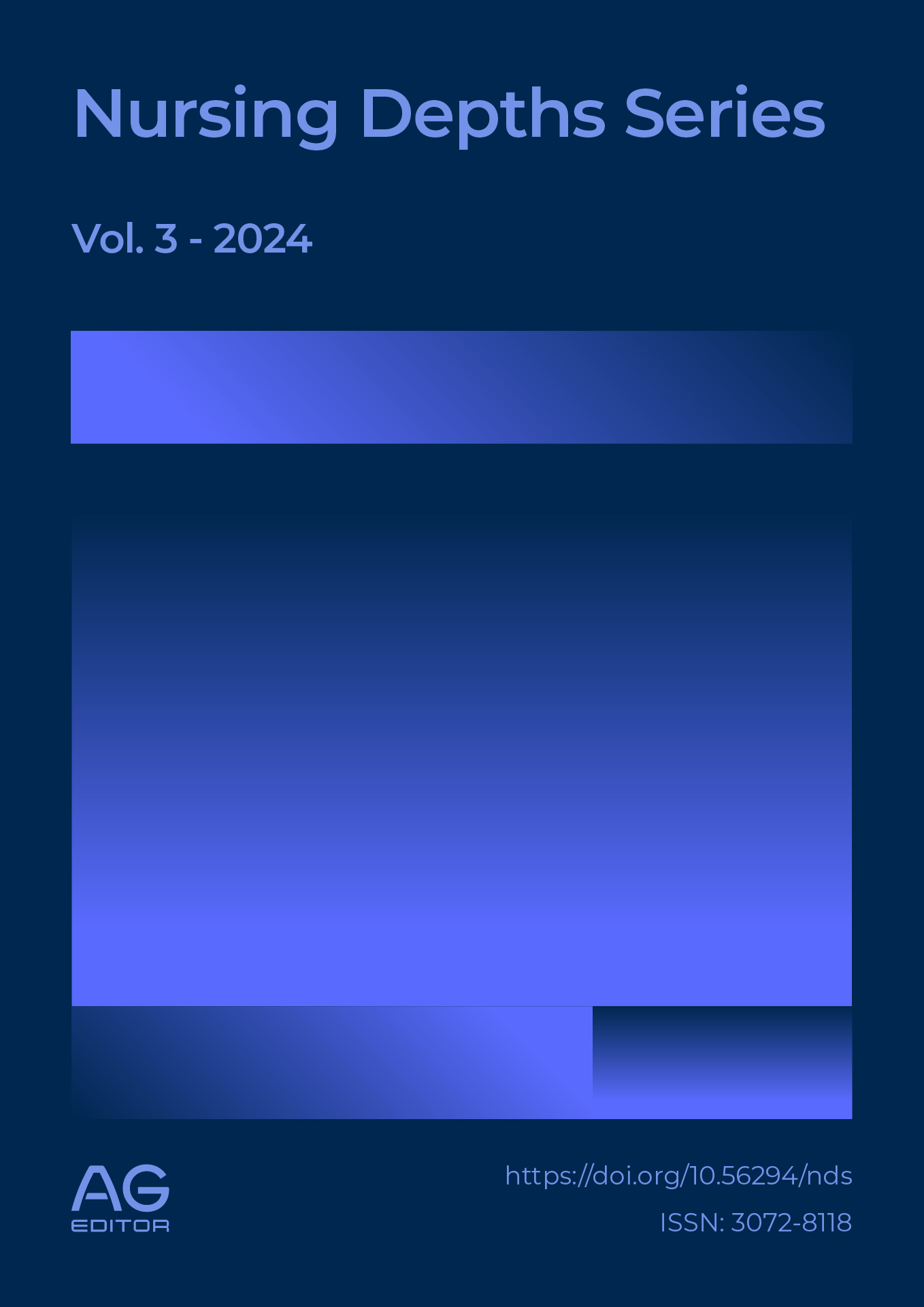Stress in nurses working in health facilities during the COVID-19 pandemic in North Lima
DOI:
https://doi.org/10.56294/nds2024120Keywords:
Stress, Occupational stress, Nursing professionals, Mental HealthAbstract
Work-related stress in nursing professionals is one of the most common problems within their work environment. Factors such as a shortage of biosafety equipment, high patient demand, and inadequate communication between staff cause stress to increase considerably, interfering with quality patient care. Therefore, the research objective is to determine the stress level in nurses working in healthcare facilities during the COVID-19 pandemic in North Lima. This is a quantitative, descriptive, cross-sectional study with a population of 255 nurses who answered a sociodemographic data questionnaire and the Spanish version of the Nursing Stress Scale. The results showed that 22.4% of professionals with service between 1 and 5 years had low stress, 43.9% medium stress, and 33.6% high stress. In conclusion, strategies should be implemented to maintain the mental health of nurses through counseling with specialized mental health professionals.
References
[1] E. Kakeman, P. Raeissi, S. Raoofi, A. Soltani, M. Sokhanvar, and D. Visentin, “Occupational stress and associated risk factors among nurses: a cross-sectional study,” Contemp. Nurse, vol. 55, no. 3, pp. 237–249, 2019, doi: 10.1080/10376178.2019.1647791?scroll=top. DOI: https://doi.org/10.1080/10376178.2019.1647791
[2] Organización Panamericana de la Salud, “Estrés laboral es una carga para los individuos, los trabajadores y las sociedades,” OPS, 2020. https://www3.paho.org/hq/index.php?option=com_content&view=article&id=11973:workplace-stress-takes-a-toll-on-individuals-employers-and-societies&Itemid=0&lang=es#gsc.tab=0
[3] Organización Internacional del Trabajo, “Estrés en el trabajo : un reto colectivo,” OIT, 2016. https://www.ilo.org/wcmsp5/groups/public/---ed_protect/---protrav/---safework/documents/publication/wcms_466549.pdf
[4] S. Cassiani, E. Munar, A. Umpiérrez, M. Peduzzi, and C. Leija, “La situación de la enfermería en el mundo y la Región de las Américas en tiempos de la pandemia de COVID-19,” Rev. Panam. Salud Publica/Pan Am. J. Public Heal., vol. 44, no. 1, p. e64, 2020, doi: 10.26633/RPSP.2020.64. DOI: https://doi.org/10.26633/RPSP.2020.64
[5] J. De los Santos and L. Labrague, “Impact of COVID-19 on the Psychological Well-Being and Turnover Intentions of Frontline Nurses in the Community: A Cross-Sectional Study in the Philippines,” medRxiv, vol. 1, no. 1, pp. 1–27, 2020, doi: 10.1101/2020.08.05.20167411. DOI: https://doi.org/10.1037/trm0000294
[6] I. Layali, M. Ghajar, E. Abedini, S. Emadian, and M. Joulaei, “Role of Job Stressors on Quality of Life in Nurses,” J. Manzadaran Univ. Med. Sci., vol. 29, no. 180, pp. 129–133, 2019, Accessed: Nov. 05, 2022. [Online]. Available: https://jmums.mazums.ac.ir/article-1-12238-en.pdf.
[7] B. Meneses, N. Gonzalez, W. Alvarado, and J. Meneses, “Stress in nursing professionals who work in the first line of care against covid – 19 in north lima,” J. Med. Pharm. Allied Sci., vol. 10, no. 6, pp. 3937–3941, 2021, doi: 10.22270/JMPAS.V10I6.1732. DOI: https://doi.org/10.22270/jmpas.V10I6.1732
[8] I. Ricci et al., “Impact of viral epidemic Outbreaks on mental health of healthcare workers: A rapid systematic review,” Med Rxiv, vol. 4, no. 6, pp. 1–92, 2020, doi: 10.1101/2020.04.02.20048892. DOI: https://doi.org/10.1101/2020.04.02.20048892
[9] M. Shah, N. Gandrakota, J. Cimiotti, N. Ghose, M. Moore, and M. Ali, “Prevalence of and Factors Associated with Nurse Burnout in the US,” JAMA Netw. Open, vol. 4, no. 2, pp. 1–11, Feb. 2021, doi: 10.1001/jamanetworkopen.2020.36469. DOI: https://doi.org/10.1001/jamanetworkopen.2020.36469
[10] P. García, A. Jiménez, L. Hinojosa, G. Gracia, L. Cano, and A. Abeldaño, “Estrés laboral en enfermeras de un Hospital Público de la zona fronteriza de México, en el contexto de la pandemia COVID-19,” Rev. Salud Publica, vol. 1, no. 1, pp. 65–73, 2020, doi: 10.31052/1853.1180.
[11] G. Cobos, A. Soriano, and M. Seijo, “Estrés laboral en Enfermería de Cuidados Críticos,” SANUM Rev. Cient. Sanit., vol. 5, no. 4, pp. 74–85, 2021, Accessed: Nov. 05, 2022. [Online]. Available: https://www.revistacientificasanum.com/pdf/sanum_v5_n4_a9.pdf.
[12] S. Maharaj, T. Lees, and S. Lal, “Prevalence and risk factors of depression, anxiety, and stress in a cohort of Australian nurses,” Int. J. Environ. Res. Public Health, vol. 16, no. 1, pp. 1–10, Jan. 2019, doi: 10.3390/ijerph16010061. DOI: https://doi.org/10.3390/ijerph16010061
[13] A. Reza, N. Gahassab, and A. Fathnezhad, “Nurses’ job stress and its impact on quality of life and caring behaviors: a cross-sectional study,” BMC Nurs., vol. 21, no. 1, pp. 1–10, Dec. 2022, doi: 10.1186/s12912-022-00852-y. DOI: https://doi.org/10.1186/s12912-022-00852-y
[14] A. Veda and R. Roy, “Occupational Stress Among Nurses: A Factorial Study with Special Reference to Indore City,” J. Health Manag., vol. 22, no. 1, pp. 67–77, Mar. 2020, doi: 10.1177/0972063420908392. DOI: https://doi.org/10.1177/0972063420908392
[15] J. Yan, C. Wu, Y. Du, S. He, L. Shang, and H. Lang, “Occupational Stress and the Quality of Life of Nurses in Infectious Disease Departments in China: The Mediating Role of Psychological Resilience,” Front. Psychol., vol. 13, no. 1, pp. 1–11, Mar. 2022, doi: 10.3389/fpsyg.2022.817639. DOI: https://doi.org/10.3389/fpsyg.2022.817639
[16] J. Lucero, D. Noroña, and V. Vega, “Estrés laboral y autopercepción de la salud en médicos y enfermeras del área de emergencia en Riobamba, Ecuador,” Rev. Cuba. Reumatol., vol. 23, no. 1, pp. 1–17, 2020, Accessed: Nov. 05, 2022. [Online]. Available: http://www.revreumatologia.sld.cu/index.php/reumatologia/article/view/945/pdf_1.
[17] R. Obando, J. Arevalo, R. Aliaga, and M. Obando, “Ansiedad, estrés y depresión en enfermeros de emergencia Covid-19,” Index de Enfermería, vol. 29, no. 4, pp. 1–9, 2021, Accessed: Nov. 05, 2022. [Online]. Available: https://scielo.isciii.es/scielo.php?script=sci_arttext&pid=S1132-12962020000300008.
[18] C. Fernández and P. Baptista, “Metodología de la Investigación.” p. 634, 2015, [Online]. Available: http://observatorio.epacartagena.gov.co/wp-content/uploads/2017/08/metodologia-de-la-investigacion-sexta-edicion.compressed.pdf.
[19] R. Más and V. Escribá, “La Versión Castellana de la Escala ‘The Nursing Stress Scale’. Proceso de Adaptación Transcultural,” Rev Esp Salud Pública, vol. 72, no. 1, pp. 529–538, 1998, [Online]. Available: https://scielo.isciii.es/pdf/resp/v72n6/castellana.pdf. DOI: https://doi.org/10.1590/S1135-57271998000600006
[20] P. Gray and J. Anderson, “The Nursing Stress Scale: Development of an instrument,” J. Behav. Assess., vol. 3, no. 1, pp. 11–23, 1981, doi: 10.1007/BF01321348. DOI: https://doi.org/10.1007/BF01321348
Published
Issue
Section
License
Copyright (c) 2024 Rafael Romero-Carazas, Victor Cornejo-Aparicio, Jessica Karina Saavedra-Vasconez, Milagros Andrea Bracho Rivera, Alejandro Carías (Author)

This work is licensed under a Creative Commons Attribution 4.0 International License.
The article is distributed under the Creative Commons Attribution 4.0 License. Unless otherwise stated, associated published material is distributed under the same licence.






